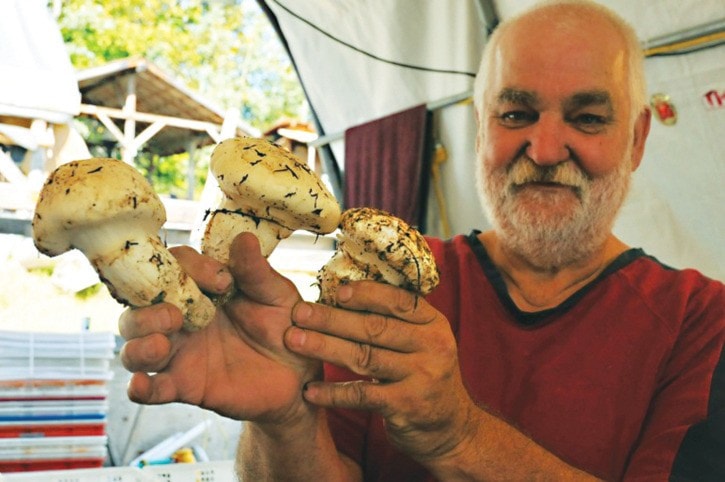Prized by the Japanese for its distinct spicy door, Pine mushrooms, also known as Matsutake, are once again popping in the forests around outlying areas of the Hazeltons.
According to mushroom buyers, despite the rainy summer and cooler temperatures, things seem to be on schedule as normal.
Found in coniferous forests made up of fir and or pine, the mushrooms start appearing as early as the middle of August and continue to flourish until approximately the end of September.
The mushrooms have been revered by the Japanese for more than a thousand years and until the 17th century, they were only consumed by members of the imperial court.
Nowadays, it is still more than just a seasonal delicacy and they symbolize fertility, good fortune and happiness. They are also traditionally given as gifts, especially in the corporate world.
Prices can range drastically from as much as $2,000 per kilogram to lower than $20 per kilogram. A few weeks ago buyers in the Hazeltons were paying $22 per pound, but they were down to $11 per pound this past weekend. At one time mushroom harvesting could be very lucrative in the Hazeltons with prices as high as $100 per pound, but those days are most likely gone forever according to buyers.
Yet despite the flux in prices, people are still out combing the woods for the money mushrooms. Some pickers say it is like finding 20 and 50 dollar bills in the moss.
However, while many people make a part or full time living harvesting pines in the fall, finding these ellusive mushrooms is not as easy as one would think.
They are typically found on south facing slopes under mixed conifers in salal or moss, along creeks and on hilltops, at the base of trees and the sides of hills.
They like well drained soil and can be found singly or in pairs or clusters. Finding flags which are already open mushrooms is easier and once located one can feel around under the moss for the coveted buttons which bring the most value.
For pickers and buyers, it is proper protocol to disturb the area as little as possible and place the lifted moss back to protect the growing area. Not to mention the fact most mushroom harvesters don’t like to share their hot spots and go through great efforts to keep their patches hidden.
While the Matustake grow in many provinces in Canada, the largest harvests are found in British Columbia. In the north the season is considerably shorter but they can be found into December on Vancouver Island if the conditions are right.
For those who are interested in wandering around in the woods and trying their luck at finding the pines, there are a few things seasoned harvesters warn about.
Take a GPS or compass as wandering around in the forests always looking down can quickly disorient people and many pickers over the years have gotten lost. With that said, it would not hurt to carry an emergency kit and snacks as well, one picker added.
One should also tell someone else where and when they are going.
As previously stated, it is very important to not disturb the area and people are reminded to take care in protecting the forests as well as taking out any garbage such as wrappers.
There is more money in the buttons than the flags and there are also several videos and books available to newcomers which pickers advise should be watched or read before venturing out.
Of course the best way to learn is to go with someone who is experienced, but that is much harder to find than the mushrooms themselves sometimes.
